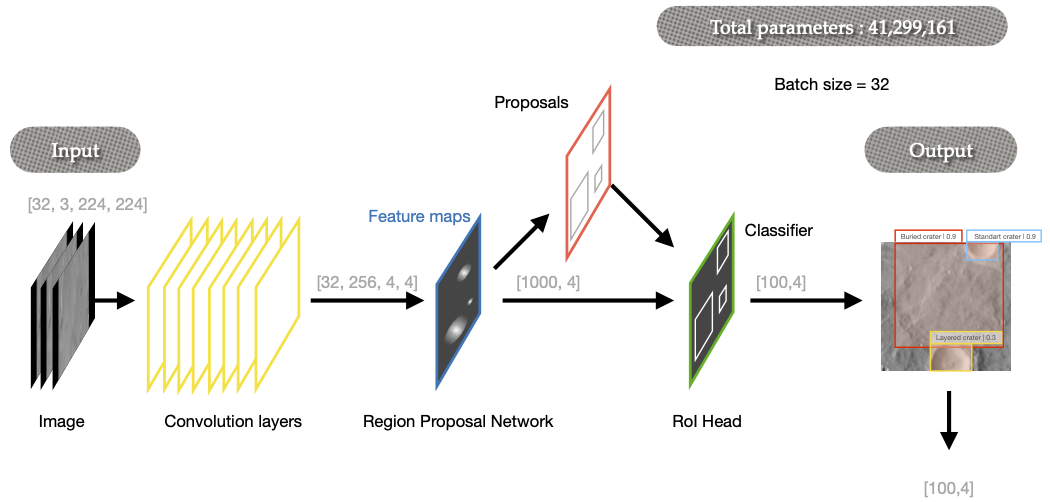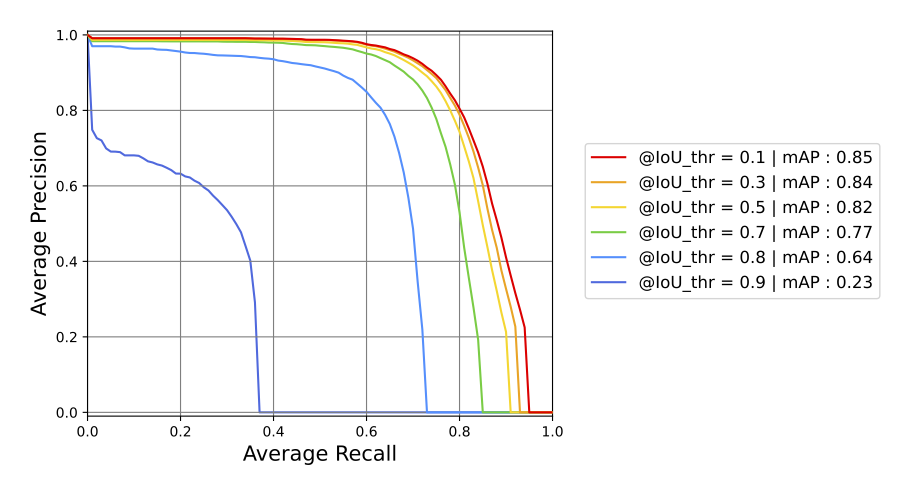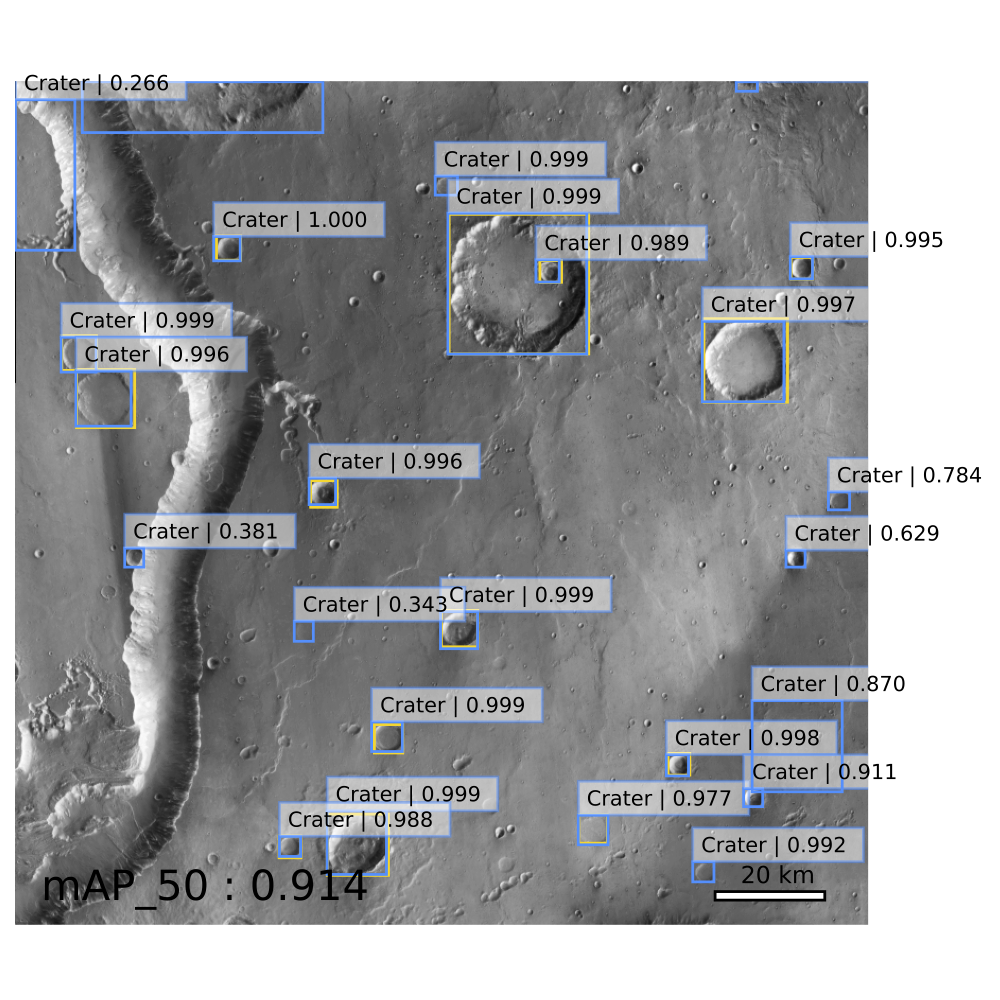Automatic crater detection and classification using Faster R-CNN
- 1Géosciences Paris Saclay (GEOPS), Université Paris Saclay, bâts. 504 & 509, 91405 ORSAY Cedex - France
- 2Institut Universitaire de France, Paris - France
- 3European Space Astronomy Centre (ESAC) Camino bajo del Castillo, s/n, Urbanización Villafranca del Castillo,, Villanueva de la Cañada, E-28692 Madrid - Espagne
- 4CentraleSupélec, Université Paris-Saclay, Inria Centrale Supélec, L'Institut National de Recherche en Informatique et en Automatique (INRIA), Université Paris Sud, Université Paris Saclay, 3 Rue Joliot Curie, 91190 Gif-sur-Yvette - France
Introduction: Understanding the distribution and characteristics of impact craters on planetary surfaces is essential if we want to understand the geological processes such as tectonic deformation, volcanism1, erosion, transport, and impact cratering itself2 which constantly rebuilt planetary surfaces. By analysing the distribution and the density of crater using the "crater counting" approach, it is possible to estimate the age of the planetary surface3 at regional scale. Historically, crater detection has been made manually. For Mars and the Moon, the existing handmade databases4,5,6 brings an inestimable value to the community. Nevertheless, even with corrective analysis7, manual databases are subject to human limitations. Indeed, studies have shown that human attention to repetitive tasks, such as crater counting, rapidly decreases after 30 minutes8and then errors started to occur. Several machine learning and AI-based approaches have been proposed to automatically detect craters on planetary surface images9,10,11.
Data: To train our machine learning algorithm, we basically need two kind of data. We need images for the detection and a global crater database which encompass the ground truth. In this work we took images from the context camera on board of the Mars Reconnaissance Orbiter (CTX) and preprocess by the Bruce Murray Laboratory of Caltech12. For the crater database we took A. Lagain’s global martian database which encompass more than 376000 craters of a size bigger than 1 km in diameter7.
Method: In this work, we presents a novel approach using the Faster Region-based Convolutional Neural Network (Faster R-CNN) for automatic crater detection13. As shown in Fig. 1, Faster R-CNN employs three stages: CNN backbone extracts features, RPN generates ROIs with anchor boxes predicting object presence and adjustments, and Detector refines object classification and bounding box coordinates, ensuring precise object detection and localization in images.

Fig. 1 : Faster R-CNN architecture as describe by S.Ren & al, 201613 with our image configuration
The proposed method involves a preprocessing step in which we cut the images to a size of 224x224 pixels, we reproject the images in order to be sure that crater will always have a circular shape at ever latitude and we split the crater database to have a ground truth label for each image. Then, we train our model with 82874 images and we test our detector on 4828 images.
Results: Extensive experiments on high-resolution planetary imagery demonstrate excellent performances with a mean average precision mAP50 > 0.82 with an intersection over union criterion IoU ≥ 0.5, independent of crater scale (Fig.2 & 3).

Fig. 2 : Precision as a function of recall for six different IoU thresholds.
Fig. 3 : Precision vs Recall curves for an IoU = 0.5 and for different bounding box sizes of the test dataset.
The Fig. 4 show an example on an equatorial Mars quadrangle.

Fig. 4 : Inference on an equatorial region of Mars. The lower right corner of this 4°×4°
quadrangle is located at 44°W, 0°N. The yellow boxes represent the ground truth infor-
mation and the blue boxes the predictions ones. Please
note that crater smaller than 10 pixels in diameter are ignored.
The results also highlight the versatility and potential of our robust model for automating the analysis of craters across different celestial bodies. The automatic crater detection tool holds great promise for future scientific research of space exploration missions.
References:
[1] : M. H. Carr, Volcanism on mars 78 (20) 4049–4062. doi:10.1029/ jb078i020p04049.
[2] : Hartmann, William K., and Gerhard Neukum. "Cratering chronology and the evolution of Mars." Chronology and Evolution of Mars: Proceedings of an ISSI Workshop, 10–14 April 2000, Bern, Switzerland. Springer Netherlands, 2001.
[3] : G. Neukum, B. A. Ivanov, W. K. Hartmann, Cratering records in the in- ner solar system in relation to the lunar reference system, in: Chronology and Evolution of Mars: Proceedings of an ISSI Workshop, 10–14 April 2000, Bern, Switzerland, Springer, 2001, pp. 55–86.
[4] : Head III, James W., et al. "Global distribution of large lunar craters: Implications for resurfacing and impactor populations." science 329.5998 (2010): 1504-1507.
[5] : S. J. Robbins, A new global database of lunar impact craters¿ 1–2 km: 1. crater locations and sizes, comparisons with published databases, and global analysis, Journal of Geophysical Research: Planets 124 (4) (2019) 871–892
[6] : S. J. Robbins, B. M. Hynek, A new global database of mars impact craters ≥ 1 km: 1. database creation, properties, and parameters, Jour- nal of Geophysical Research: Planets 117 (E5) (2012).
[7] : A. Lagain, S. Bouley, D. Baratoux, C. Marmo, F. Costard, O. De- laa, A. P. Rossi, M. Minin, G. Benedix, M. Ciocco, et al., Mars crater database: A participative project for the classification of the morpho- logical characteristics of large martian craters, geoscienceworld (2021).
[8] : J. E. See, S. R. Howe, J. S. Warm, W. N. Dember, Meta-analysis of the sensitivity decrement in vigilance., Psychological bulletin 117 (2) (1995) 230.
[9] : Salamuniccar, Goran, and Sven Loncaric. "Method for crater detection from martian digital topography data using gradient value/orientation, morphometry, vote analysis, slip tuning, and calibration." IEEE transactions on Geoscience and Remote Sensing 48.5 (2010): 2317-2329.
[10] : G. Benedix, A. Lagain, K. Chai, S. Meka, S. Anderson, C. Norman, P. Bland, J. Paxman, M. Towner, T. Tan, Deriving surface ages on mars using automated crater counting, Earth and Space Science 7 (3) (2020) e2019EA001005.
[11] : R. La Grassa, G. Cremonese, I. Gallo, C. Re, E. Martellato, YOLOLens: A deep learning model based on super-resolution to enhance the crater detection of the planetary surfaces, Remote Sensing 15 (5) (2023) 1171. doi:10.3390/rs15051171.
[12] : Dickson, L.A.Kerber, C.I.Fassett, B.L.Ehlmann, A global, blended ctx mosaic of mars with vectorized seam mapping: a new mosaicking pipeline using principles of non-destructive image editing., 49th Lunar and Planetary Science Conference (2018).
[13] : S. Ren, K. He, R. Girshick, J. Sun, Faster r-cnn: Towards real-time object detection with region proposal networks (2016). arXiv:1506. 01497.
How to cite: Martinez, L., Schmidt, F., Andrieu, F., Bentley, M., and Talbot, H.: Automatic crater detection and classification using Faster R-CNN, Europlanet Science Congress 2024, Berlin, Germany, 8–13 Sep 2024, EPSC2024-1005, https://doi.org/10.5194/epsc2024-1005, 2024.